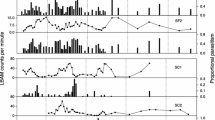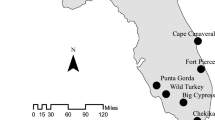Abstract
The ability to establish successfully in a new area can vary considerably among species. In addition to the well-recognized importance of propagule pressure in driving the rates of establishment of biological invaders, the life history strategy of a species can also affect establishment success, such as in the extent to which Allee effects (positive density-dependence), and environmental and demographic stochasticity manifest themselves. We quantified the establishment success of Adelges tsugae, a non-native insect currently invading North American hemlock. We inoculated eastern hemlock host trees with varying densities of this parthenogenetic insect, from 1 to >500 progrediens ovisacs. The number of settled sistens (the subsequent generation) was positively related to the initial density. More interesting, however, was that we recorded successful establishment from released progrediens ovisacs, and the subsequent initiation of the next generation (sistens), in ≈39 % of host trees inoculated with 1 ovisac. The observation that successful establishment can be accomplished by a single ovisac produced by a single individual has important implications in the invasion dynamics and management of A. tsugae.



Similar content being viewed by others
References
Allee WC (1938) The social life of animals. W.W. Norton and Company, Inc., New York, NY
Beirne BP (1975) Biological control attempts by introductions against pest insects in the field in Canada. Can Entomol 107:225–236
Butin E, Preisser E, Elkinton J (2007) Factors affecting settlement rate of the hemlock woolly adelgid, Adelges tsugae, on eastern hemlock, Tsuga canadensis. Agric For Entomol 9:215–219
Courchamp F, Clutton-Brock T, Grenfell B (1999) Inverse density dependence and the Allee effect. Trends Ecol Evol 14:405–410
Courchamp F, Berec L, Gascoigne J (2008) Allee effects in ecology and conservation. Oxford University Press, Oxford
Drake JA, Lodge DM (2006) Allee effects, propagule pressure and the probability of establishment: risk analysis for biological invasions. Biol Invasions 8:365–375
Evans AM, Gregoire TG (2007) A geographically variable model of hemlock woolly adelgid spread. Biol Invasions 9:369–382
Gascoigne JC, Lipcius RN (2004) Allee effects driven by predation. J Appl Ecol 41:801–810
Gascoigne J, Berec L, Gregory S, Courchamp F (2009) Dangerously few liaisons: a review of mate-finding Allee effects. Popul Ecol 51:355–372
Gómez S, Orians CM, Preisser EL (2012) Exotic herbivores on a shared native host: tissue quality after individual, simultaneous, and sequential attack. Oecologia 169:1015–1024
Gouger RJ (1971) Control of Adelges tsugae on hemlock in Pennsylvania. Scientific Tree Topics 3:1–9
Hastings A, Cuddington K, Davies KF, Dugaw CJ, Elmendorf S, Freestone A, Harrison S, Holland M, Lambrinos J, Malvadkar U, Melbourne B, Moore K, Taylor C, Thompson D (2005) The spatial spread of invasions: new developments in theory and evidence. Ecol Lett 8:91–101
Havill NP, Foottit RG (2007) Biology and evolution of Adelgidae. Annu Rev Entomol 52:325–349
Havill N, Montgomery M, Yu G, Shiyake S, Caccone A (2006) Mitochondrial DNA from hemlock woolly adelgid (Hemiptera: Adelgidae) suggests cryptic speciation and pinpoints the source of the introduction to eastern North America. Ann Entomol Soc Am 99:195–203
Havill N, Montgomery M, Keena M (2011) Hemlock woolly adelgid and its hemlock hosts: a global perspective. In: Onken B and Reardon R (eds) Implementation and status of biological control of the hemlock woolly adelgid. U.S. Forest Service, Publication FHTET-2011-04, Morgantown, WV, pp. 3–14
Hengeveld R (1989) Dynamics of biological invasions. Chapman and Hall, London
Hopper KR, Roush RT (1993) Mate finding, dispersal, number released, and the success of biological control introductions. Ecol Entomol 18:321–331
Johnson DM, Liebhold AM, Tobin PC, Bjørnstad ON (2006) Allee effects and pulsed invasion of the gypsy moth. Nature 444:361–363
Lagalante A, Lewis N, Montgomery M, Shields K (2006) Temporal and spatial variation of terpenoids in eastern hemlock (Tsuga canadensis) in relation to feeding by Adelges tsugae. J Chem Ecol 32:2389–2403
Lande R (1993) Risks of population extinction from demographic and environmental stochasticity and random catastrophes. Am Nat 142:911–927
Lande R (1998) Demographic stochasticity and Allee effect on a scale with isotropic noise. Oikos 83:353–358
Leung B, Drake JM, Lodge DM (2004) Predicting invasions: propagule pressure and the gravity of Allee effects. Ecology 85:1651–1660
Liebhold AM, Bascompte J (2003) The Allee effect, stochastic dynamics and the eradication of alien species. Ecol Lett 6:133–140
Liebhold AM, Tobin PC (2008) Population ecology of insect invasions and their management. Annu Rev Entomol 53:387–408
Lockwood JL, Cassey P, Blackburn T (2005) The role of propagule pressure in explaining species invasions. Trends Ecol Evol 20:223–228
Lockwood JL, Hoopes M, Marchetti M (2007) Invasion ecology. Blackwell Publishing Ltd., Malden, MA
Ludsin SA, Wolfe AD (2001) Biological invasion theory: Darwin’s contributions from The Origin of Species. Bioscience 51:780–789
McClure MS (1989) Evidence of a polymorphic life cycle in the hemlock woolly adelgid, Adelges tsugae (Homoptera: Adelgidae). Ann Entomol Soc Am 82:50–54
McClure MS (1990) Role of wind, birds, deer, and humans in the dispersal of hemlock woolly adelgid (Homoptera: Adelgidae). Environ Entomol 19:36–43
McClure MS (1991) Density dependent feedback and population cycles in Adelges tsugae (Homoptera: Adelgidae) on Tsuga canadensis. Environ Entomol 20:258–264
McClure MS (1992) Hemlock woolly adelgid. Am Nurseryman 175:82–89
McClure MS, Cheah AS-J (1999) Reshaping the ecology of invading populations of the hemlock woolly adelgid, Adelges tsugae (Homoptera: Adelgidae), in eastern North America. Biol Invasions 1:247–254
Miles PW (1990) Aphid salivary secretions and their involvement in plant toxicases. In: Cambell RK, Eikenbary RD (eds) Aphid–plant–genotype interactions. Elsevier, New York, pp 131–147
Morin RS, Liebhold AM, Luzader ER, Lister AJ, Gottschalk KW, Twardus DB (2005) Mapping host-species abundance of three major exotic forest pests. Research Paper NE-726, USDA Forest Service, Newtown Square, PA
Neter J, Wasserman W, Kutner MH (1990) Applied linear statistical models, 3rd edn. Irwin, Inc., Burr Ridge, IL
Onken B, Reardon R (2011) Implementation and status of biological control of the hemlock woolly adelgid. U.S. Forest Service, Publication FHTET-2011-04, Morgantown, WV
Orwig DA, Foster DR, Mausel DL (2002) Landscape patterns of hemlock decline in New England due to the introduced hemlock woolly adelgid. J Biogeogr 29:1475–1487
Paradis A (2011) Population dynamics of hemlock woolly adelgid (Adelges tsugae) in New England. University of Massachusetts, Amherst, MA, p 114
Paradis A, Elkinton J, Hayhoe K, Buonaccorsi J (2008) Role of winter temperature and climate change on the survival and future range expansion of the hemlock woolly adelgid (Adelges tsugae) in eastern North America. Mitig Adapt Strat Glob Change 13:541–554
Raffa KF, Berryman AA (1983) The role of host plant resistance in the colonization behaviour and ecology of bark beetles. Ecol Monogr 53:27–49
R Development Core Team (2012) The R project for statistical computing http://www.r-project.org
Shigesada N, Kawasaki K (1997) Biological invasions: theory and practice. Oxford University Press, New York, NY
Simberloff D (2009) The role of propagule pressure in biological invasions. Annu Rev Ecol Evol Syst 40:81–102
Simberloff D, Gibbons L (2004) Now you see them, now you don’t! Population crashes of established introduced species. Biol Invasions 6:161–172
Skinner M, Parker BL, Gouli S, Ashikaga T (2003) Regional responses of hemlock woolly adelgid (Homoptera: Adelgidae) to low temperatures. Environ Entomol 32:523–528
Stadler B, Müller T, Orwig D, Cobb R (2005) Hemlock woolly adelgid in New England forests: canopy impacts transforming ecosystem processes and landscapes. Ecosystems 8:233–247
Stephens PA, Sutherland WJ, Freckleton RP (1999) What is the Allee effect? Oikos 87:185–190
Suarez AV, Holway DA, Case TJ (2001) Patterns of spread in biological invasions dominated by long-distance jump dispersal: insights from Argentine ants. Proc Natl Acad Sci USA 98:1095–1100
Tobin PC, Whitmire SL, Johnson DM, Bjørnstad ON, Liebhold AM (2007) Invasion speed is affected by geographic variation in the strength of Allee effects. Ecol Lett 10:36–43
Tobin PC, Berec L, Liebhold AM (2011) Exploiting Allee effects for managing biological invasions. Ecol Lett 14:615–624
Trotter RT III, Shields KS (2009) Variation in winter survival of the invasive hemlock woolly adelgid (Hemiptera: Adelgidae) across the eastern United States. Environ Entomol 38:577–587
Wallace MS, Hain FP (2000) Field surveys and evaluation of native and established predators of the hemlock woolly adelgid (Homoptera: Adelgidae) in the Southeastern United States. Environ Entomol 29:638–644
Wellborn G, Capps E (2012) Establishment of a new population by a single gravid colonist: implications for Hyalella biogeography and speciation. Evol Ecol. doi:10.1007/s10682-012-9579-x (in press)
Williamson M, Fitter A (1996) The varying success of invaders. Ecology 77:1661–1666
Young RF, Shields KS, Berlyn GP (1995) Hemlock woolly adelgid (Homoptera: Adelgidae): stylet bundle insertion and feeding sites. Ann Entomol Soc Am 88:827–835
Acknowledgments
We would like to thank Laura Blackburn, Terry Burhans, Will Harris, John Juracko, Gino Luzader, Dani Martin, Adam Miller, George Racin, Brian Simpson, Elliott Tobin, and Lindsay Wolf for valuable field and laboratory assistance. We thank John and Judy Stewart for the use of their farm. We are also very grateful to Joe Elkinton (University of Massachusetts) and Mike Montgomery (USDA Forest Service, Northern Research Station, retired) who provided helpful advice during the initial planning stages of this study. Nathan Havill and Sandy Liebhold (USDA Forest Service, Northern Research Station) provided helpful comments on an earlier draft.
Author information
Authors and Affiliations
Corresponding author
Additional information
This work is dedicated to our dear friend and colleague, Dan Snider, who tragically passed away prior to the completion of this paper.
Daniel A. Snider: Deceased.
Rights and permissions
About this article
Cite this article
Tobin, P.C., Turcotte, R.M. & Snider, D.A. When one is not necessarily a lonely number: initial colonization dynamics of Adelges tsugae on eastern hemlock, Tsuga canadensis . Biol Invasions 15, 1925–1932 (2013). https://doi.org/10.1007/s10530-013-0421-3
Received:
Accepted:
Published:
Issue Date:
DOI: https://doi.org/10.1007/s10530-013-0421-3




